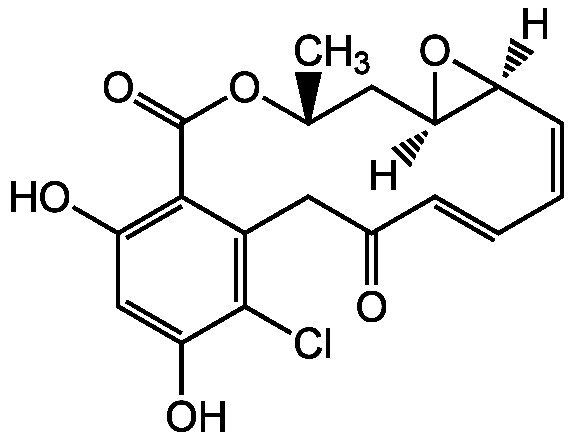Radicicol
Product Code: AG-CN2-0021
Product Group: Natural Products and Extracts
Supplier: AdipoGen Life Sciences
| Code | Size | Price |
|---|
| AG-CN2-0021-M001 | 1 mg | £55.00 |
Quantity:
| AG-CN2-0021-M005 | 5 mg | £190.00 |
Quantity:
Prices exclude any Taxes / VAT
Overview
Regulatory Status: RUO
Shipping:
Ambient
Storage:
-20°C
Images
Documents
Further Information
Alternate Names/Synonyms:
Monorden; NSC 294404; RHI-12648
Appearance:
White to slightly yellow solid.
CAS:
12772-57-5
Class:
6.1
EClass:
32160000
Form (Short):
liquid
GHS Symbol:
GHS06,GHS08
Handling Advice:
Keep cool and dry.Protect from light.
Hazards:
H301, H315, H319, H335, H340, H350
InChi:
1S/C18H17ClO6/c1-9-6-15-14(25-15)5-3-2-4-10(20)7-11-16(18(23)24-9)12(21)8-13(22)17(11)19/h2-5,8-9,14-15,21-22H,6-7H2,1H3/b4-2+,5-3-/t9-,14+,15-/m1/s1
InChiKey:
WYZWZEOGROVVHK-HAJNAQHISA-N
Long Description:
Chemical. CAS: 12772-57-5. Formula: C18H17ClO6. MW: 364.8. Isolated from Gilmaniella sp. Antibiotic. Protein tyrosine kinase inhibitor. Has antifungal, antimalarial, antiangiogenic (in vivo), anti-inflammatory and antiviral activity. Cyclooxygenase-2 (COX-2) expression inhibitor without affecting COX-1 expression in LPS-stimulated macrophages. Induces the differentiation of HL-60 cells into macrophages. Potent HSP90 inhibitor. Anticancer compound. In vivo Rad/Raf interaction inhibitor. Inhibitor of AP-1-, NF-kappaB- and serum response factor (SRF)-mediated transcription. Suppresses expression of iNOS (NOS II). Non-competitive inhibitor of ATP citrate lyase. DNA topoisomerase VI and type II DNA topoisomerase inhibitor. Protects against LPS/IFN-gamma-induced neuronal cell death. Apoptosis inducer.
MDL:
MFCD06795865
Molecular Formula:
C18H17ClO6
Molecular Weight:
364.8
Package Type:
Vial
PG:
III
Precautions:
P201, P261, P280, P301, P310, P302, P352, P304, P340, P405
Product Description:
Antibiotic [1]. Protein tyrosine kinase inhibitor [1]. Has antifungal [4], antimalarial [6], antiangiogenic (in vivo) [2], anti-inflammatory [5] and antiviral activity. Cyclooxygenase-2 (COX-2) expression inhibitor without affecting COX-1 expression in LPS-stimulated macrophages [3, 5]. Induces the differentiation of HL-60 cells into macrophages [4]. Potent HSP90 inhibitor [7, 9, 12]. Anticancer compound [7, 9, 12]. In vivo Rad/Raf interaction inhibitor [8]. Inhibitor of AP-1-, NF-kappaB- and serum response factor (SRF)-mediated transcription. Suppresses expression of iNOS (NOS II) [10]. Non-competitive inhibitor of ATP citrate lyase [11]. DNA topoisomerase VI and type II DNA topoisomerase inhibitor [13]. Protects against LPS/IFN-gamma-induced neuronal cell death [14]. Apoptosis inducer [16]. Pyruvate dehydrogenase kinase 3 (PDK3) inhibitor, by binding directly to the ATP-binding pocket [15].
Purity:
>99% (HPLC)
Signal word:
Danger
SMILES:
[H][C@@]12C[C@@H](C)OC(=O)C3=C(O)C=C(O)C(Cl)=C3CC(=O)C=CC=C/[C@]1([H])O2
Solubility Chemicals:
Soluble in DMSO, methanol, acetone, ethyl acetate or chloroform.
Source / Host:
Isolated from Gilmaniella sp.
Transportation:
Excepted Quantity
UN Nummer:
UN 3462
UNSPSC Category:
Natural Products/Extracts
UNSPSC Number:
12352200
Use & Stability:
Stable for at least 2 years after receipt when stored at -20°C. Store solutions at -20°C in the dark.
References
Potent and specific inhibition of p60v-src protein kinase both in vivo and in vitro by radicicol: H.J. Kwon, et al.; Cancer Res. 52, 6926 (1992) | Radicicol, a microbial cell differentiation modulator, inhibits in vivo angiogenesis: T. Oikawa, et al.; Eur. J. Pharmacol. 241, 221 (1993) | Radicicol, a protein tyrosine kinase inhibitor, suppresses the expression of mitogen-inducible cyclooxygenase in macrophages stimulated with lipopolysaccharide and in experimental glomerulonephritis: P. Chanmugam, et al.; J. Biol. Chem. 270, 5418 (1995) | Induction of differentiation of HL-60 cells by the anti-fungal antibiotic, radicicol: Y. Shimada, et al.; J. Antibiot. 48, 824 (1995) | Inhibitor of protein tyrosine kinase, radicicol, suppresses the expression of cyclooxygenase and pro-inflammatory cytokines in LPS-stimulated rat alveolar macrophage in part by accelerating degradation of mRNA: L. Feng, et al.; Adv. Exp. Med. Biol. 407, 281 (1997) | Antimalarial activity of radicicol, heptelidic acid and other fungal metabolites: Y. Tanaka, et al.; J. Antibiot. 51, 153 (1998) | Targeting of the protein chaperone, HSP90, by the transformation suppressing agent, radicicol: S.V. Sharma, et al.; Oncogene 16, 2369 (1998) | Identification of radicicol as an inhibitor of in vivo Ras/Raf interaction with the yeast two-hybrid screening system: S.W. Ki, et al.; J. Antibiot. 51, 936 (1998) | Structural basis for inhibition of the Hsp90 molecular chaperone by the antitumor antibiotics radicicol and geldanamycin: S.M. Roe, et al.; J. Med. Chem. 42, 260 (1999) | Radicicol suppresses expression of inducible nitric-oxide synthase by blocking p38 kinase and nuclear factor-kappaB/Rel in lipopolysaccharide-stimulated macrophages: Y.J. Jeon, et al.; J. Pharmacol. Exp. Ther. 294, 548 (2000) | Radicicol binds and inhibits mammalian ATP citrate lyase: S.W. Ki, et al.; J. Biol. Chem. 275, 39231 (2000) | Heat shock protein 90 (Hsp90) chaperone complex inhibitor, radicicol, potentiated radiation-induced cell killing in a hormone-sensitive prostate cancer cell line through degradation of the androgen receptor: K. Harashima, et al.; Int. J. Radiat. Biol. 81, 63 (2005) | The HSP90 and DNA topoisomerase VI inhibitor radicicol also inhibits human type II DNA topoisomerase: D. Gadelle, et al.; Biochem. Pharmacol. 72, 1207 (2006) | Protective effect of radicicol against LPS/IFN-gamma-induced neuronal cell death in rat cortical neuron-glia cultures: M.J. Sohn, et al.; Life Sci. 80, 1706 (2007) | Distinct Structural Mechanisms for Inhibition of Pyruvate Dehydrogenase Kinase Isoforms by AZD7545, Dichloroacetate, and Radicicol: M. Kato, et al.; Cell Structure 15, 992 (2007) | Radicicol, an inhibitor of Hsp90, enhances TRAIL-induced apoptosis in human epithelial ovarian carcinoma cells by promoting activation of apoptosis-related proteins: Y.J. Kim, et al.; Mol. Cell Biochem. 359, 33 (2012)



